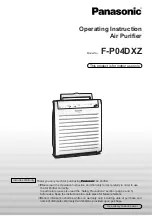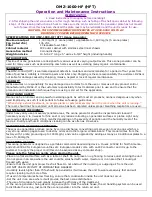
6
Preliminary checks
- Check that the filter bag (30) has been fitted in the container
(25) and that the filters (23) have been fitted on the head;
- Check that the vacuum hose is properly fixed and does not hin-
der tool movement;
- Check that there are no leaks in the compressed air supply system.
MACHINE USE
The machine can operate in manual or automatic mode: to select
the mode, turn the switch (12) to the right (automatic mode) or to
the left (manual mode) (pic. 20). The green led indicator (13) turns
on when the vacuum motor start.
Using the machine in automatic mode (A
)
Automatic operations means that the vacuum starts when an
electrical or pneumatic tool, connected to the anterior panel pow-
er outlet (16) or pneumatic quick coupling (17) (Version P only),
is turned on.
The vacuum will automatically turn off eight seconds after the tool
is turned off.
Using the machine in manual mode (M
)
Manual operations means that the vacuum runs continuously.
Power on the anterior panel outlet is permanently active during
manual running.
WARNING
Do not plug to the anterior panel receptacles
loads exceeding the Amperes indicated.
Adjusting the vacuum level
The vacuum level can be adjusted in both operating modes by
turning the knob (12) inside the range “min” “max”, until the de-
sired power is reached.
Automatic cleaning of the filters (VERSION “E”)
The machine has a timed filter cleaning system that maintains the
vacuum strength constant.
It is also possible to perform a complete cleaning cycle as follows
(pic. 16):
- Switch the machine off;
- Cap the vacuum sleeve;
- Restart the machine keeping the sleeve capped for 15 seconds.
Wet vacuum (VERSION “E”)
Before vacuuming liquids, remove the filter bag and replace the
paper filters cartridges with polyester ones. The filters should be
damp after vacuuming.
WARNING
Do not operate with dry dust with wet filters!
Liquid level indicator (VERSION “E”)
Thermal Limiter
The appliance motor is provided with a Thermal Limiter to avoid
any overheating and/or overcurrent during abnormal or not cor-
rect use.
If the appliance works intermittently, immediately disconnect the
ment-grounding conductor can result in a risk of electric shock.
Check with a qualified electrician or service person if you are in
doubt as to whether the outlet is properly grounded. Do not mod-
ify the plug provided with the appliance – if it will not fit the outlet,
have a proper outlet installed by a qualified electrician
Compressed air mains
- Do not exceed 6 bar;
- Dried and filtered air required;
- Connect the appliance to the compressed air main with a hose
suitable for the air pressure and with an inner diameter of 10
mm min.
Assemble the Nozzle adaptor
(29)
Insert the adaptor in the inlet nozzle (28).
Electric tool connections
- Check for the tool switch turned off before connecting it to the
anterior panel power outlet;
- Insert the tool plug into the anterior panel power outlet (16) (pic. 3);
- Connect the tool to the hose and the hose to the vacuum clean-
er, by means of the nozzle adaptor (29) (pic. 5);
- Do not plug electric tools exceeding the Amperes indicated on
the label near the anterior panel power outlet.
Pneumatic tool connections
- Check for the tool switch turned off before connecting it to the
front panel quick coupling;
- Connect the tool to the appliance by means of the quick cou-
plings (17) (pic. 4) and (18) (pic. 6);
- Connect the coaxial hose (optional) to the quick coupling (20) (pic.6).
Check the tool is functioning as indicated on its instruction manual.
Extension Cord
Make sure your extension cord is in good condition and is the
correct size for your appliance. Table below shows the correct
size to use depending on extension cord length. If in doubt, use
the next heavier gage. The smaller the gage number, the heavier
the cord. An undersized extension cord will cause a drop in line
voltage resulting in loss of power and overheating. Do not exceed
the extension cord length in the table.
Extension Cord Length (feet)
25
50
Not recommended
Cable Conductor Size (AWG)
14
12
--
Use only three-wire extension cords that have three-prong
grounding plugs and grounding receptacles that accept the ap-
pliance’s plug.
Use only U.L. and CSA listed extension cords. Never use two
extension cords together. Instead, use one long one.
WARNING
– To reduce the risk of personal injury due to a loose
electrical connection between the appliance’s plug and extension
cord, firmly and fully attach the appliance plug to the extension cord.
Periodically check the connection while operating to ensure it is fully
attached. Do not use an extension cord that provides a loose con-
nection.
A loose connection may result in overheating, fire, and increases
the risk of a burning.
To reduce the risk of disconnection of the appliance cord from the ex-
tension cord during operating make a knot as shown in Figure below:


































